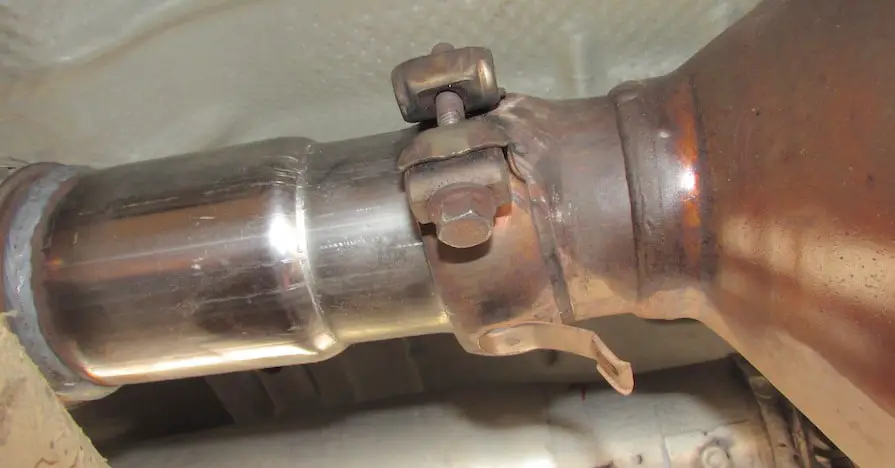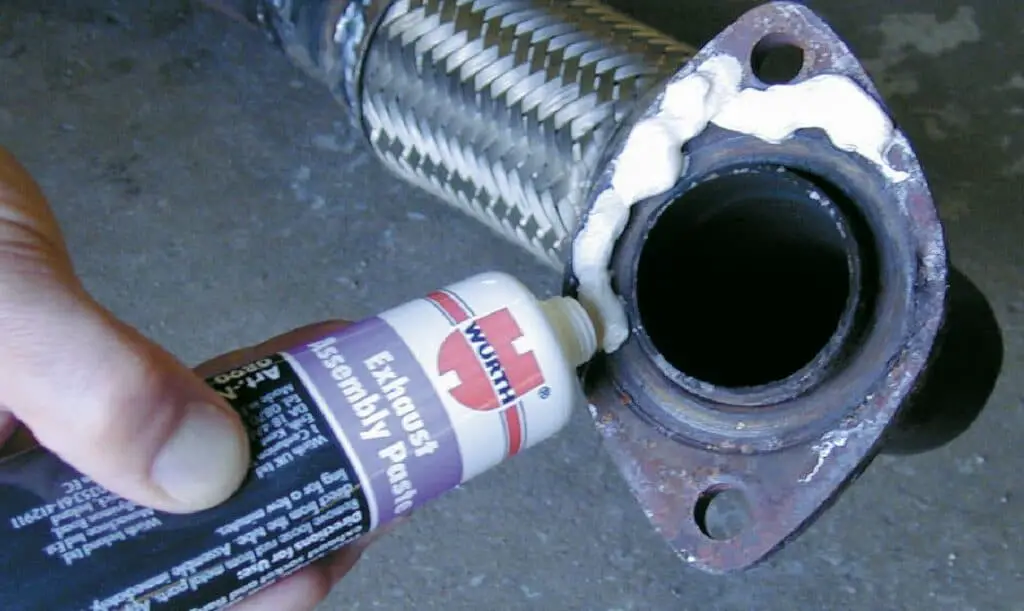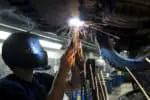Exhaust pipes are long enough and have bents in them, so they need to be joined by parts!
In order to join the exhaust pipes and to ensure there is no leak out, you need to either weld the joints or use exhaust clamps!
 Now, the question is which is better?
Now, the question is which is better?
Exhaust clamps or welding?
Both exhaust clamps and welding have their own advantages and disadvantages.
While exhaust clamps are easy to install, welding involves a lot of training and handling complex steps which makes use of shielding gas, electricity, welding torch, filler rods, etc. If you want to install exhaust pipe setup at home, clamping is far better an option and I will tell you why!
You can definitely use exhaust clamps instead of welding for the simple reason that clamping will provide the same stability to your exhaust pipe system and they are easy to repair as well. You just need bolts and nuts to set the clamp and while repairing you just need to tighten or change the clamps.
In this article I will discuss more about why exhaust clamps should be your first choice and what the process to clamp your exhaust pipes is! Also, I will mention the different ways to seal the leakages instead of welding and does exhaust need to be welded?
So, let’s dive deeper…
How do you clamp exhaust pipes together?
Exhaust pipes are meant to direct the fumes out of the engines or any machine. And what an exhaust clamp does is that they hold the exhaust pipes together. Exhaust pipes also keep away carbon monoxide from entering the vehicles.
Therefore, setting the exhaust clamps correctly is very essential and this is how you can do it:
1.) Your safety should be your first priority. Wear your safety gloves and safety glasses before beginning with the process.
2.) First of all you need to disassemble the exhaust clamp. In order to do so, loosen the clamps and remove the hex nuts from the bolt that is “U” shaped.
3.) Next you need to place the saddle over the exhaust pipe connection.
4.) Then slide the saddle and thread one hex nut on each leg-side of the U bolt but don’t tighten the nuts at this stage.
5.) Now put pressure on the exhaust pipe connection to make the connection seated.
6.) Take a socket matching the size of the hex nuts and attach it to the ratchet and then set the ratchet to tighten.
7.) Next, slide the socket on one of the hex nuts and then tighten the nut.
8.) Now, repeat the above steps for the other hex nuts.
9.) At last, to ensure that the exhaust clamp is set tight, pull it and then tighten the nuts if required.
Does exhaust need to be welded?
Clearly no!
There is absolutely no need to weld your exhaust clamps. The bolts and nuts are enough to hold the exhaust clamps tightly together.
But if you detect any leakage in the exhaust pipes even after fixing them with the bolts and nuts, you definitely have to look for a second option to mend the leakage and that is when you should think of welding the joints to seal the exhaust pipes.
Welding the exhaust pipes will ensure that the joints will not leak out the gas and cause hazards!
How can I seal my exhaust without welding?
There are various ways to seal the leakage in the exhaust without welding and here’s the best ways I have mentioned below:
1.) Seal the exhaust using an exhaust clamp:
All you need to do is cover the part of the leakage in the exhaust with the clamp and use bolts and nuts to tighten the clamp. Your leakage will be sealed
2.) Seal the exhaust using epoxy bond:

In case the leakage is small, you can make use of the epoxy glue for sealing the holes. Apply the epoxy covering area a bit extra than the hole and let the epoxy dry to seal the leakage.
3.) Seal the exhaust using exhaust tape:
You can get the exhaust tapes in any hardware store in your locality or can get it from amazon.com. Once you get hold of the tape, wrap it around the hole in the pipe covering a few inches extra in radius. Apply a second layer of the tape if required.
4.) Seal the exhaust using an aluminium patch:
Wrap the aluminium patch around the leakage in the pipe and secure the aluminium patch with epoxy or using hose clamps.
See also: What flame to use to weld aluminium?
Is it better to clamp exhaust or weld?
If you ask me, I will always say that using clamp exhaust is a far better idea than welding if you are doing tasks for your household.
If you are trying to install a new exhaust component at home then clamping would be the easiest and safest option for you for the simple reason that clamping does not involve complex process as in welding such as use of electricity, shielding gas, torch, etc. for clamping, you will need just bolts and nuts and in terms of servicing, you just need to tighten the bolts!
How much does it cost to have exhaust welded?
If you want to weld your exhaust, it will cost you around 200$.
The costing involves, per hour wages of the welder which is not less than 2 hours work, rent of the welding equipment, electricity charges, etc.
It also depends on the number of joints to be welded and the radius of the pipes!
And it’s a wrap:
Clamping is always better than welding for the simple reason that it is easier to clamp than to weld and repairing the clamp is easier than repairing the weld. Also, if you look at the costing, clamping is definitely cheaper than welding.
You don’t need any experience or training in clamping but you definitely need one in welding! You don’t have to depend on the welder to come and repair your exhaust pipes if you clamp exhaust!
That’s all for the day! Hope you enjoyed reading the article!






